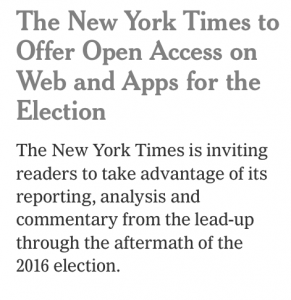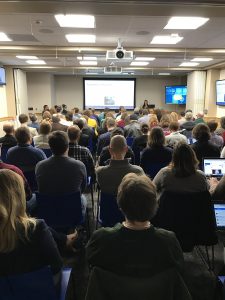For those of us in the OA community, some whiplash-inducing news broke earlier this week: Elsevier acquired bepress. I learned about the purchase from a listserv email, pointing to a blog post. My initial reaction was that surely this must be the fake news we’re hearing about these days, since I hadn’t seen any press releases from bepress or Elsevier, and such a partnership seemed sort of antithetical, given how libraries tend to see Elsevier and the OA movement as diametrically opposed (I equate bepress here with the OA movement, since they’re best known for Digital Commons, an institutional repository that many libraries use for supporting their OA initiatives). After some digging around, I found the press release and James Comey’s “mildy nauseous” feeling sank in the pit of my gut.
I shared this news with my colleagues at a Library & IT leadership meeting yesterday. Since folks on the IT side of the house are not as familiar with Elsevier and the OA movement, I told them to imagine that the famously-orphaned Harry Potter announced with great joy that he was being adopted by Lord Voldemort. I realize this analogy is over-the-top and unfair, but it describes how I felt after hearing the news, and I do think it sort of describes the tone of the acquisition.
I often use Elsevier as a foil when I evangelize open access. They’re a great antagonist to the OA protagonist I paint. Here’s an easy way of preaching the OA gospel:
- Look at your annual spend with Elsevier (probably a lot)
- Calculate what percentage of your materials budget that is (likely a big slice of pie)
- Look at Elsevier’s profit margins (30.7% in 2016)
- Determine how many of your faculty published with Elsevier in the past year (they publish lots of good and important journals, so it’s probably a decent amount)
- Point out that most author agreements ask the author to forfeit his or her copyright.
- Figure out how much Elsevier has paid those professors for their excellent scholarship (hint: $0).
- Look at point # 1 again.
I like using that approach when explaining the merits of OA because it’s based on real numbers/dollars, and it nicely illustrates the fact that the University is paying for access to scholarship that it funded and that its scholars produced. From here, professors are usually more willing to hop on the OA train in one way or another. Some are gung-ho and try to publish in a gold OA journal, while the more skeptical or those whose disciplines truly value publication in specific titles might opt for a green OA approach. We’re very happy with green OA.
We use bepress’s Digital Commons to host our institutional repository, where our authors can deposit their final manuscript per our Open Access policy. This allows the Bucknell community to read scholarship that their colleagues have written that we might not subscribe to. It also allows anybody in the world with internet access to benefit from our faculty’s scholarly output. Otherwise they’d have to pay $31.50 to download the article.
It really does seem so bizarre and backwards that our annual subscription fees to bepress, intended to support our OA mission, are now going into Elsevier’s coffers.
I’m very happy with the Digital Commons platform, and I’ve had nothing but wonderful experiences with the folks at bepress I’ve worked with, but this new partnership strikes me as tone deaf and seems philosophically discordant. While I don’t think we’re planning to abandon ship with Digital Commons just yet, it would be naïve of me not to start investigating other options.


